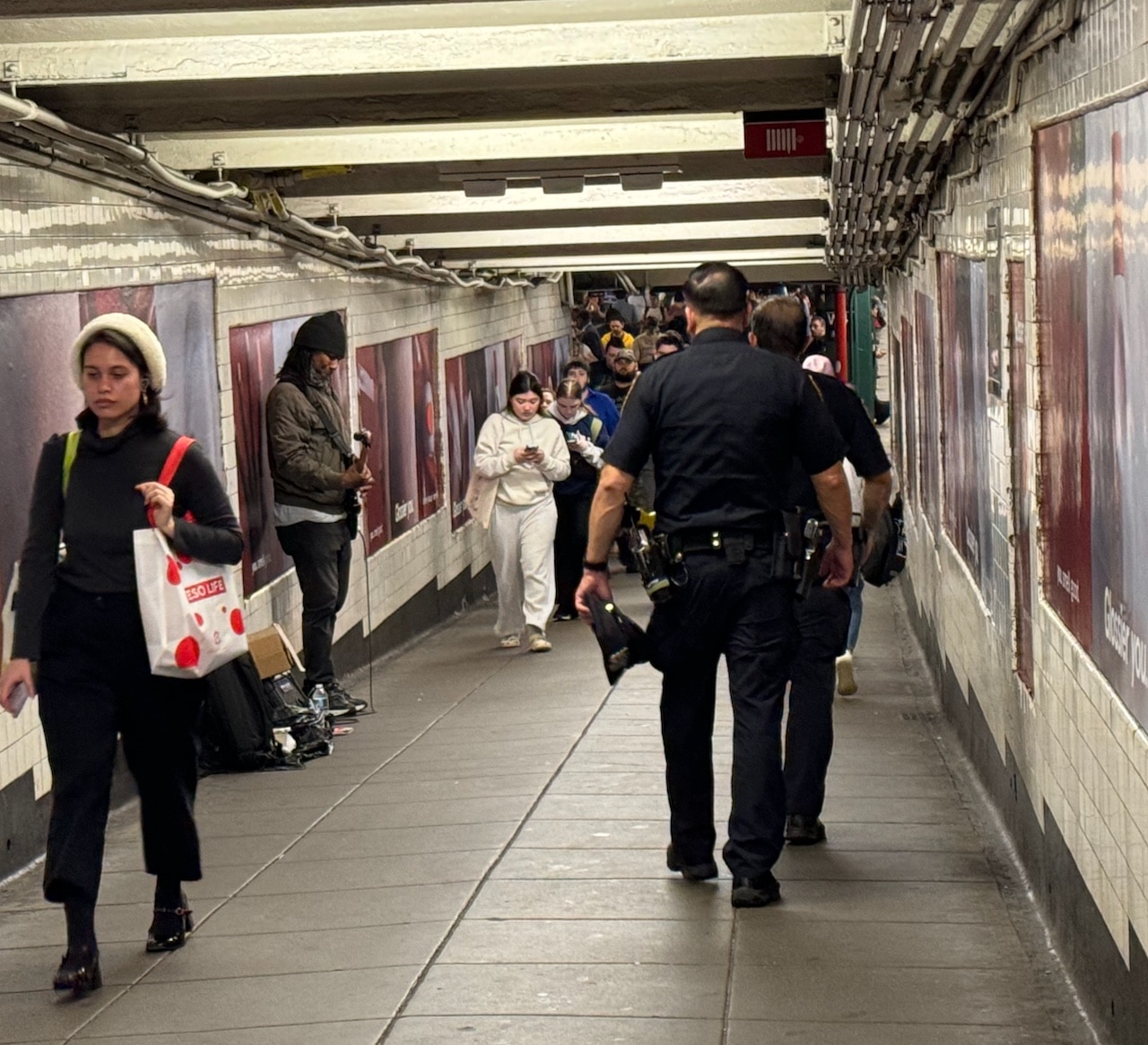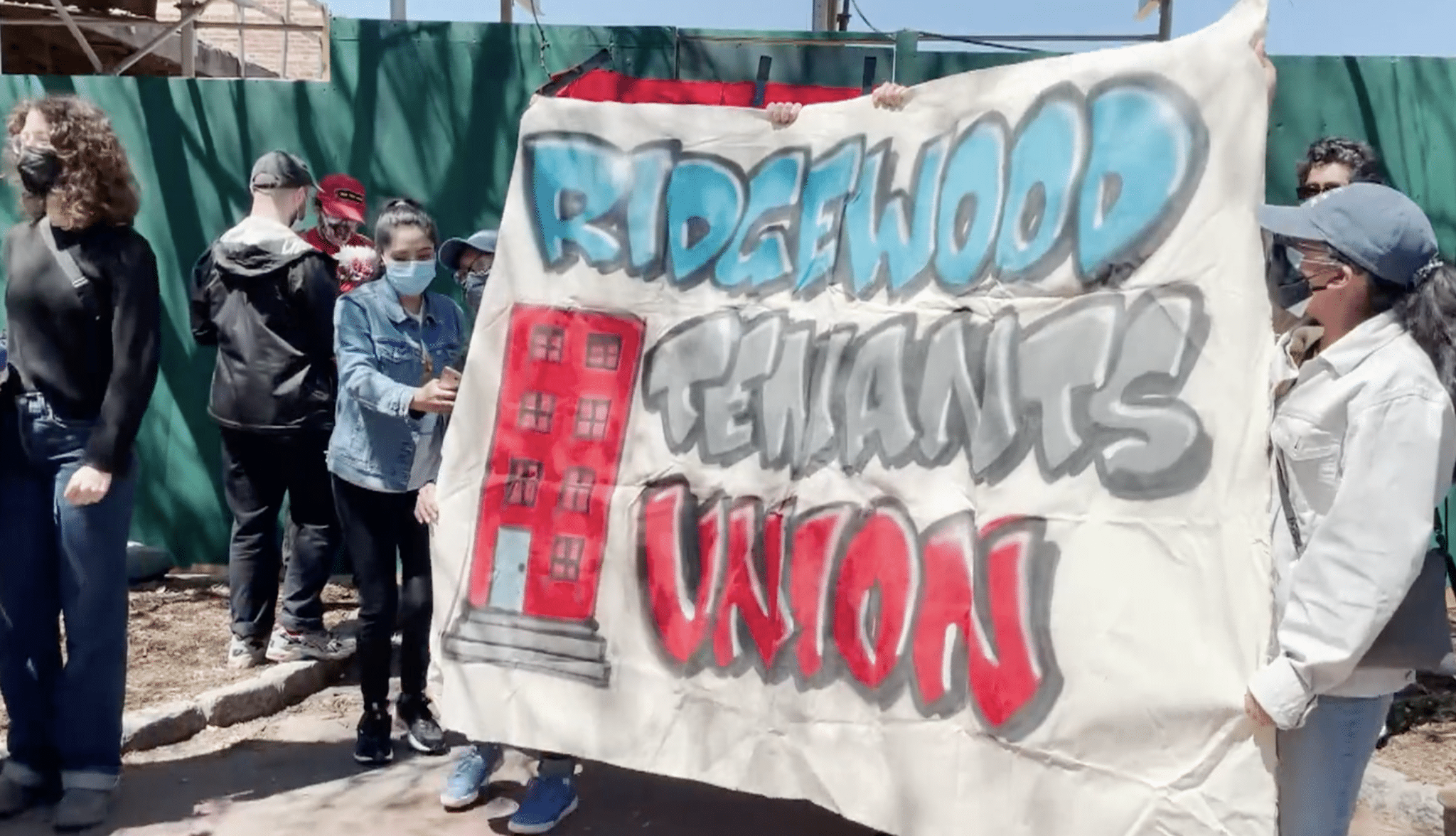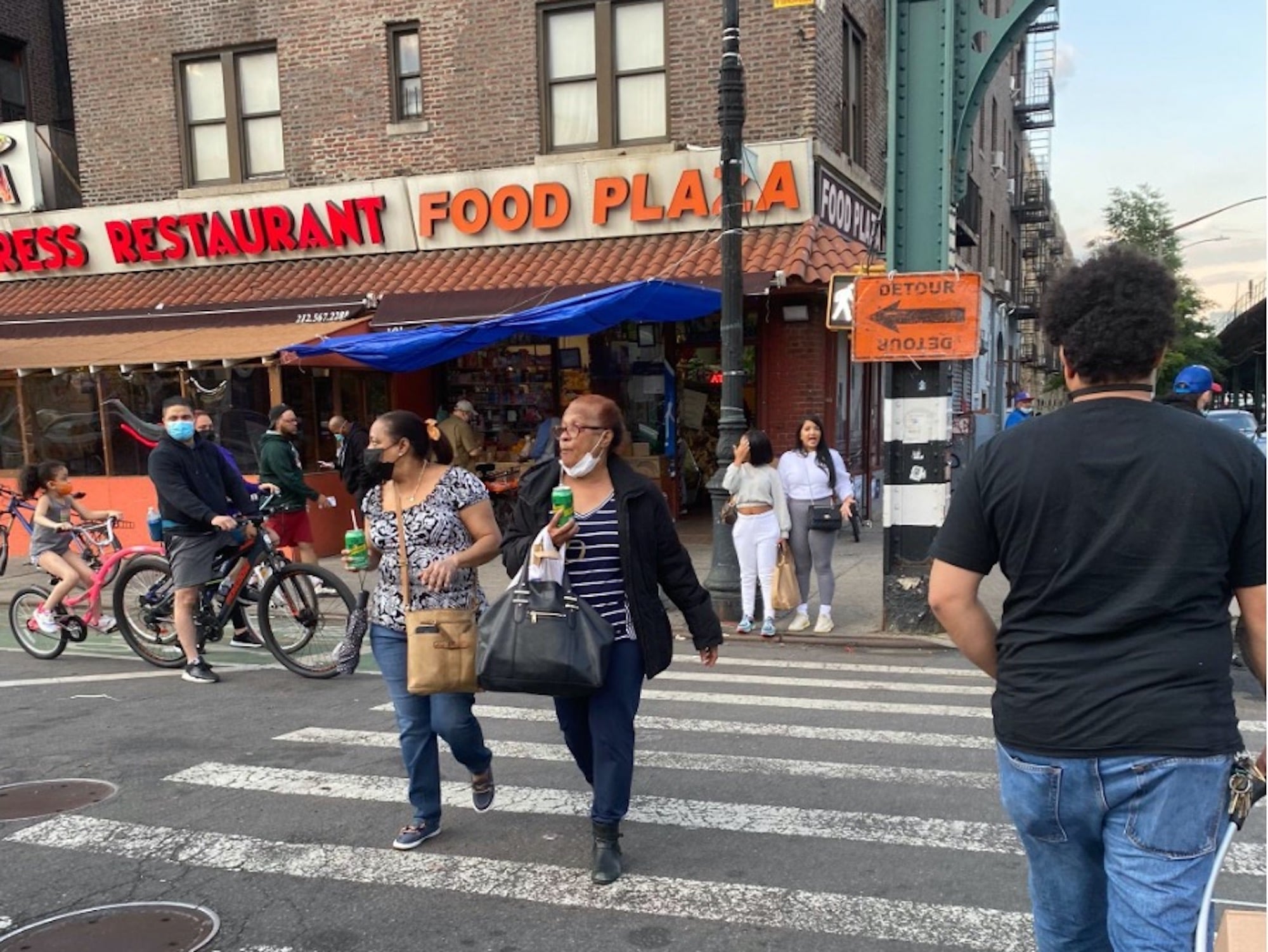Public transportation is essential for most New Yorkers. Subways and buses mostly offer a reliable commute, but crime has a lot of people worried. The concern contrasts with a drop in crime. “Overall crime in the transit system plummeted 23.5 percent in March,” according to the NYPD. Police statistics show that, “Citywide in March 2024 compared to March 2023, overall crime dropped 5 percent, a reduction of 505 incidents.” Yet on their commute to school and work, our reporters at The City College of New York (CCNY) see and experience the reason why people feel frightened. Those lucky enough to walk to school tell a different story.
Katelyn Polanco
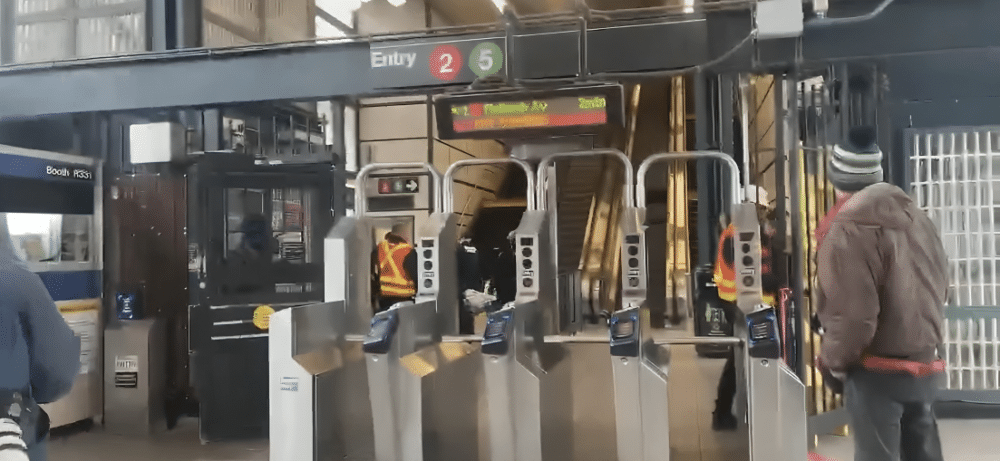
People get news that there is a man hit by a train. Photo by Kenneth Morales.
Death on the Tracks
BRONX, N.Y.
by Kenneth Morales
A person was fatally struck by a northbound train on the morning of April 28th at the Gun Hill Road Station. Police said the victim was dead by the time they arrived at the scene.
Sunday morning subway riders found police on the tracks in the Gun Hill Road Station and learned that the 2 and 5 trains weren’t running. A 9-1-1 call was made at around 8:30 a.m. and someone reported that a person was hit by a train.
“I’m waiting for my bus when I saw police show up,” said Alicia, who said she was present when law enforcement arrived on the scene. “I overheard one of them tell their partner that someone got hit by a train and then people were leaving the station, no one was allowed in.”
Passengers on a train coming from Brooklyn headed for the station said the conductor made an announcement.“I thought it was going to be a short delay until the announcer told us to get off [the train],” said Jalina Jackson. She was on her way to visit her grandmother. “I just couldn’t believe it when I heard that someone was hit by the train.”
Eyewitnesses on the scene observed EMS dragging a body in a tarp out of the Gun Hill Road station. The victim was not immediately identified. A representative from the Media Relations department of the Metropolitan Transportation Authority declined to provide extensive details, but said, “We received a report of an incident at Gun Hill Road on April 28th at 8:26 am. As a result, northbound 2 trains ran express from 180th St to 241st St for about 90 minutes.”
Getting off the Bx38 bus outside Gun Hill Rd Station, Jensen Semenou was about to go through the turnstile when MTA workers in hazard vests stopped him. “I saw people leaving the station but I didn’t pay attention to it. And when I was swiping my metro card, someone in an orange vest stopped me.” When told about the death on the tracks Semenou said, “Damn, I know I’m not going to make it into work on time, but rest in peace for the person.”
As of now, neither the police nor the MTA have released information regarding the victim.
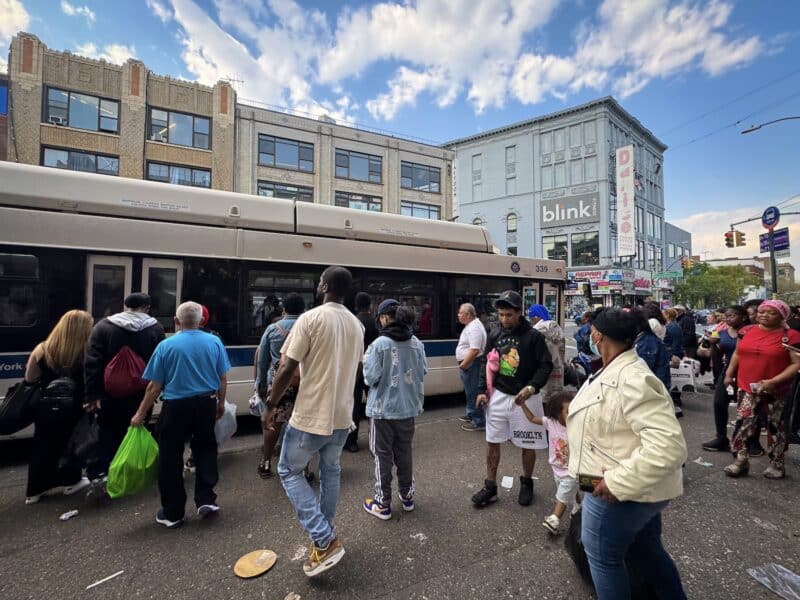
Bus Riders at 149 Street in the Bronx. Photo by Lizbeth Fuentes Asencio
You Never Know on the Bronx Bus
BRONX, N.Y.
by Lizbeth Fuentes Ascencio
As a regular rider on the BX15 and BX19 buses, I’ve witnessed firsthand the chaos that escalates when passengers are packed like sardines. Insults are often hurled, sometimes with the threat of physical altercations including stabbings. I’ve lost count how many times I’ve witnessed fights break out over an occupied seat or an accidental arm brush. There was even a fatal stabbing on the BX19 bus because of a verbal dispute between passengers.
Yet, despite the tension reeking off of people at every bus stop, I still choose to ride the MTA buses on my way to CCNY rather than the subway. Buses are regularly delayed and that means it’s only natural for aisles to be packed with people and the putrid smell of sweat or stale air upon boarding.
Passengers like Sincere R. Ortiz, feel safer using the buses than the subway, “Because you’re still out in public. You’re not going through any tunnels. So if you needed to get out– if something were happening, there’s an emergency brake on the bus,” he explained.
Passengers also know that bus drivers can stop the bus if trouble occurs.
“Somebody smokes weed and then the bus driver stops the whole entire bus for him to get out,” said Lyvette Soto. She often takes the BX15 to get the 2 or 5 train on 3rd Avenue and 149th Street. That stop is a lifeline for many residents in the South Bronx, because it is a hub where you can catch other buses, like the BX2, BX4, BX21, BX41, BX41 SBS, and M125.
A survey in fall of 2023, showed rising disapproval rates from passengers for the subway and buses. But buses had a higher satisfaction rate, at 57%, while the subway compared to 52% for for subways, according to the Metropolitan Transportation Authority. Overall, the majority agree more can be done to improve the conditions.
Still the buses seem less offensive. “The worst that I’ve seen is chips on the ground or that one time I saw shit on the seats, things like that. But again, it’s not as worse as the train,” Lyvette added.
“They [Transit workers] could clean them up better,” said Nelson Santigo, who takes the buses at 3rd Avenue and 149th Street all the time. Crime his the major comlaint. Santigo said “We don’t have enough police officers protecting us. Something has to be done. City’s outta control.”
Yet, amidst the mayhem, I’ve also seen glimmers of humanity – in chaos we exchange knowing glances rolling our eyes in solidarity, or strangers striking up friendly conversations. The shabby conditions on these buses provide the background to my commute.
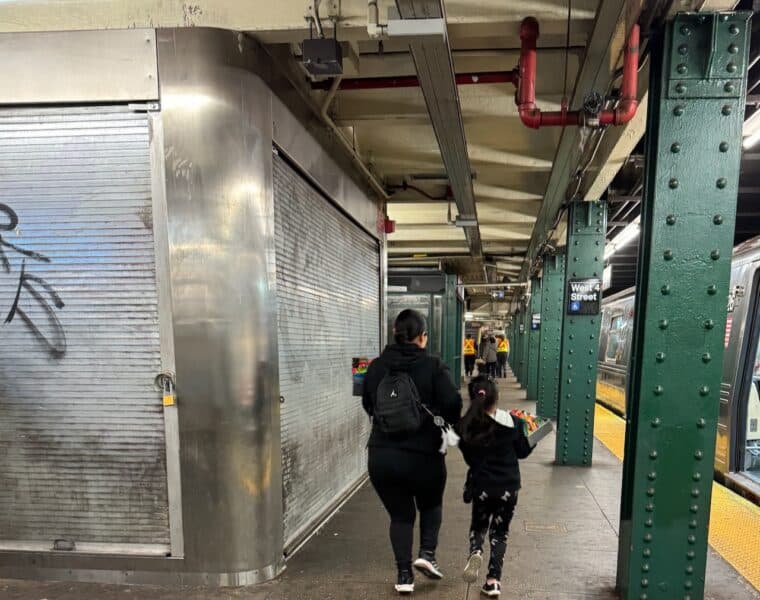
Subway Riders Talk about Candy Sellers
by Fairuz Omar Raya
QUEENS, N.Y.
Women with makeshift cloth baby carriers hold sleeping infants on their backs. They navigate the shaky jolts of the subway holding onto silver poles with one hand, and boxes filled with chocolate and candy to sell in the other.
Little kids weave in between crowds holding boxes of Twix and Trident gum as they run in between subway cars. The dynamic New York City Transit system seems like their playground.
On every train, subway riders look on with concern, unease, and conflicted feelings. Many give a dollar without making a purchase. Yet some avoid looking at them. One subway rider told Harlem View that if he didn’t make eye contact “maybe they would stop selling.”
Another rider, Jack Lucero, said, “I feel bad because they’re supposed to be in school but they’re out here making money.”
Others seemed more concerned about bigger issues. Tiffany Howard said, “It’s kind of dangerous because of the homeless. Especially now, things are dangerous with thieves and assaults. They’re so young and vulnerable, someone could just snatch them.”
Many offer different theories about the motivations of these working families. Warda B, a subway rider who chose not to give their last name said, “I know why they do this, I mean they’re newly immigrated. You know, it’s the immigrant struggle. But they should be in school.”
Similarly, Tiffany Howard said, “They do it for survival. The economy especially now, everything is so expensive.” In contrast, Carolina Leon remarked, “It’s dangerous in the streets but their parents make them do it”.
Amidst these concerns, these subway regulars think the city, the state and federal government should do more. Jack Lucero said the city needs to spend money “…to get the kids off the streets and into schools.”
People say they understand the financial needs. But they want to see kids get a better start in life. “They came to this country to make money but that should be on the parents, the kids shouldn’t have to work. We shouldn’t separate them, we should help the family so that the kids wouldn’t have to worry,” said subway rider Alexander Rymar.
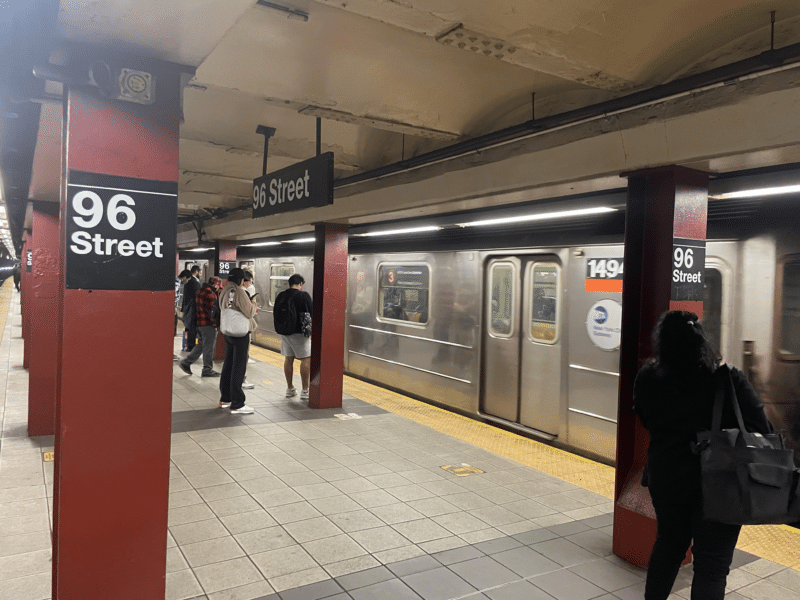
Commuters take things in their stride on the 3 Train. Photo by Yusef Abdelrazik
Confrontation on the 3 Train
by Yusuf Abdelrazik
MANHATTAN, April 18th, 2024.
The Broadway 3 Express Train was filled with people making their way downtown around 5:30 p.m. When it left the 96 Street station everything appeared normal. People had tired faces and a candy vendor walked among the passengers. But the atmosphere shifted when a man entered the train from the emergency door between cars. He was shirtless and had an overwhelmingly bad odor. He weaved through the passengers asking for change, eventually he asked the man seated next to me.
“I’m sorry I don’t have any, ” replied the man. He later introduced himself to me as Julio Giron. This set the homeless man off. He started yelling at Julio, “F*ck you, you motherf*cker, f*ck you, f*ck you!” Some passengers turned to look while others tried to ignore the situation. After giving Julio an earful the homeless man went and sat in an empty seat mumbling under his breath.
I turned to Julio and asked, “How did that make you feel?” He said, “You know, it’s unsettling. I wish I could help, but sometimes it’s just not possible. I try not to take it personally, though it happens all the time. I would be the one getting into trouble if I escalated it.”
Another passenger named Kyle Perez, a 20 -year-old, watched the scene unfold. I asked, “What do you think about what just happened?” Kyle slid his backpack strap on and shrugged. “It’s tough. We see people like that all the time on the trains, it’s a tough way to end the day.”
As the train continued towards Times Square people seemed to forget what had just happened moments ago. Just another ride on the 3 Train.

Barriers Go Up In Subway Stations
WASHINGTON HEIGHTS, N.Y.
by Julian C. Rivas
People waiting on the platform often find themselves in dangerous situations in New York City subways. Some have lost their balance and fallen onto the tracks and some have been pushed into the tracks like the man shoved and killed by an oncoming 4 train at the 125th Street Lexington Avenue station in March.
To try to protect people, the MTA began to install platform barriers. They began at the 191st Street station in Washington Heights. These barriers are precisely placed so that subway doors do not open in front of them and they also leave enough space for people to enter and exit trains safely.
Regular train goers at the 191st Street station have mixed opinions about the barriers. Some find them effective and others find them completely useless.
Hannah Garcia said, “I think it’s a great start for sure. It feels like the barriers are a good way to protect us, but not enough. I have only seen them at this station so there is still a lot more that needs to be done.”
The barriers went up in April in the Bryant Park and 42nd street station. Garcia said, “I’ve seen people talk about full platform screen doors which I would find to be much more effective.”
Emanuel Quezada said, “These things feel pointless. The MTA continues to do things nobody asks for. They may appear to be protecting us with these barriers but in all reality people can still fall into the tracks with these barriers. They seem to serve no purpose.”
But some think they will cause more problems than they solve. .
Nicaury Vargas said, “The barriers make the platforms a little more crowded and honestly make it more uncomfortable during rush hour.” Vargas continued, These barriers don’t seem to be doing much so continuing to install them would be a waste of time. If they have to continue to close down certain platforms to install these barriers it will affect all of our commutes.”
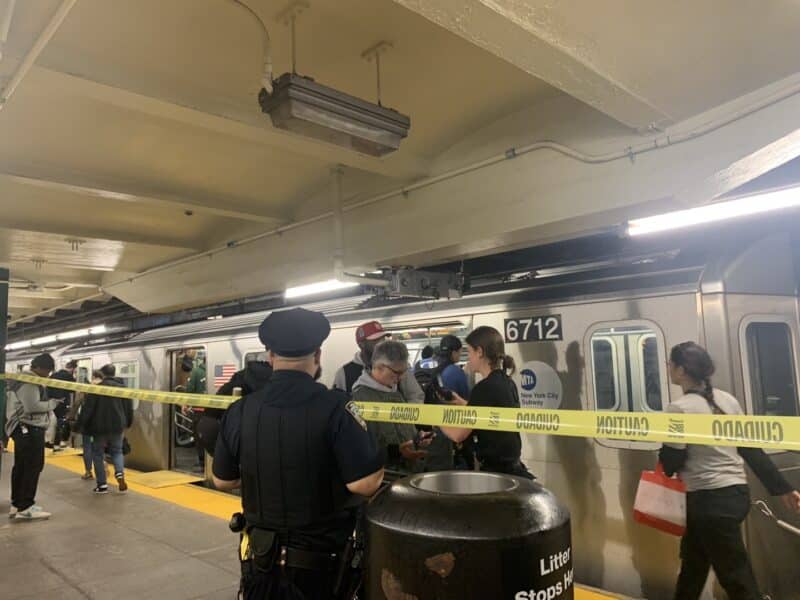
Something curious is happening on the F Train. Photo by Lizeth Jimenez.
Surprises at Church Avenue Station
BROOKLYN, N.Y.
by Lizeth Jimenz
On my commute from Kensington to City College I had two surprises. First, I saw a woman getting a free ride. As I went down the stairs at the Church Avenue train station, I spotted a woman slipping right through the emergency gate. After she saved her $2.90, she ran down the stairs to catch her Coney Island bound F train.
“That is some clutch timing, I would have done the same thing, if I’m being honest” said Antonio Tax when I asked him if he saw her. I agreed with him. If I see an opportunity to save $2.90 and if I was in a rush, I would have slipped right through as well. But this time, Tax and I tapped our phones to pay the fare.
On the Manhattan-Queens bound platform, an MTA worker guided people to the left side. A yellow caution tape cut the platform in half. On the right side, a train had stopped in the station.
There were people inside pulling off the advertisements on the side of the subway car. Someone in charge was directing people to take specific positions on the train.
Sandra Tapia, another commuter, said, “I saw the yellow tape and thought something bad happened to someone or the train, but it looks like they are going to record.” There was a lot of camera equipment and people seemed to be setting up to shoot something. “I think it might be for a movie or commercial, whatever it is I think it’s cool to see some behind the scenes,” Tapia said,
When my train came, I got on and sat next to Jayleen Gordillo. “Seeing them professional looking cameras is impressive.” she said. “It reminds me of when I saw the Joker movie and recognized the place where they filmed. There is a chase scene in the 18th Avenue station and again the Church Avenue station. Hopefully, I get to come across whatever they filmed there.”
For all of us it was just another day on the F train.
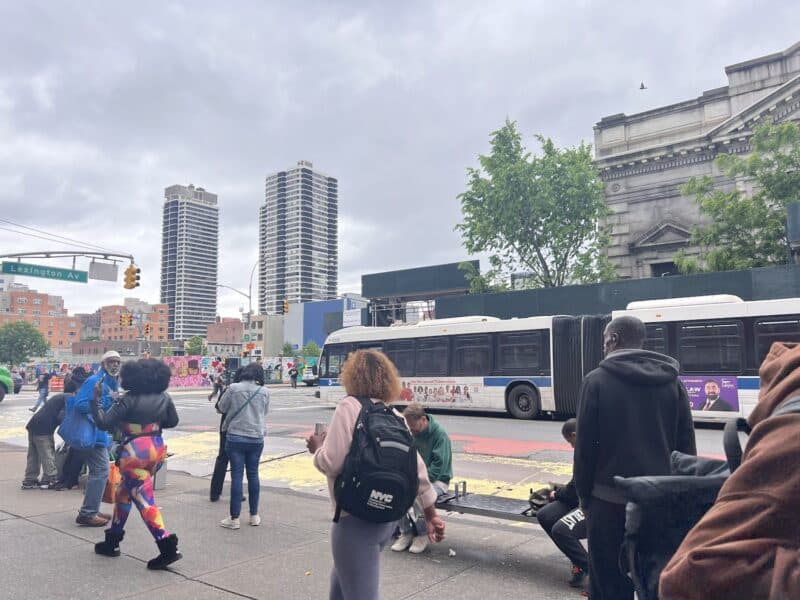
People wish they felt safer at the 125th Street and Lexington Avenue bus stop. Photo by Francine Saint-Hillaire
Violence at the 125th Street Bus Stop
by Francina Saint-Hillaire
HARLEM, N.Y.
Bus riders at East 125th St & Lexington Ave worry about the growing presence of homeless people at the bus stop. It is scary sometimes when we wait for the M101, M125, and M60-SBS buses. In April, I came out of the subway station and noticed a crowd near the bus stop. An elderly man dressed in a blue shirt, a red jacket, and jeans, held his cheek as blood seeped through his fingers from a wound on his face. Because it was raining that day, the blood fell from his cheeks and flowed along the curb. Spectators watched in shock, some pulling out their phones to record. The person who sliced the man in the face disappeared into the crowd. Nearby police officers moved to assist and called for backup. Police cars surrounded the area within minutes, and an EMT got out of an ambulance and rushed to tend to the injured man. I walked to the next block to catch the M101 because police officers blocked off that area. The attack made me want to take a different route to school.
Another student from The City College of New York (CCNY) had a similar experience. Emily Guerrero relies on the M101 for her daily commute. She recalled, “I was waiting at the bus stop and saw two homeless men get into a physical altercation. One of them had no pants on, just a shirt and underwear with a hospital bracelet. The other man had pulled out a knife and stabbed the man with no pants in the leg before running off. I was horrified.”
Even when there is no violence, regulars at the bus stop feel uncomfortable.
Yvonne Valdez, a 72-year-old relies on a walker. She finds herself in a daily battle for space with the homeless people at the bus stop benches. “I am tired of asking them to give me a seat,” she said wearily. “They occupy all the benches and never leave one open for someone elderly like me,” she says.
A lifelong Harlem resident, Kadeem Harris reflects on the bus stop change over the years. What once was a chance for social interaction for him, is now overrun by panhandlers.“Waiting for the M125 and the M101 used to be nice. I would talk to people who shared the same work route. During our talks, we’d often vent to each other about the long wait time for the bus. Now, I have to keep dogging homeless people who hassle me for a dollar,” he said.
Another Bad Scene at the 125th Street Bus Stop
by Fatima Rose Esquivel
Shortly after midnight, I was headed to the BXM9 bus stop and I encountered a man lying unconscious on the sidewalk, foaming at the mouth with vomit surrounding him. Feeling a mix of revulsion and concern, I approached a woman waiting for a Manhattan-bound bus.
“He has to be on fentanyl. They all are,” said Tamika Jones, referring to the powerful synthetic opioid that has caused 80% of drug overdoses, according to the New York City Health Department. “Must’ve been an overdose. He’s passed out. The other frequent users who sleep here are fine, but it’s every man for himself, even if he’s gone. The police have to give him Narcan.” Narcan, or naloxone, is a medication designed to rapidly reverse opioid overdoses.
Three police officers were already on the scene when the ambulance arrived. Paramedics quickly assessed the man’s condition, and carefully loaded him onto a stretcher. I watched anxiously as he was placed into the ambulance, which then sped away with sirens blaring, highlighting the urgency of the situation.
If you or someone you know is struggling with opioid addiction, resources are available to help. The National Drug Helpline can be reached at 1-844-289-0879, or you can visit their website at https://www.samhsa.gov/
A Knife on the Bus
BRONX, N.Y.
By Amari Obey
I was on my way home from City College after class. I normally take the BX 19 bus from 145th and Amsterdam to 149th and Third Avenue and walk to the BX15 in front of a McDonalds. That day in March, it was rainy, and the bus was packed. I got on the and sat within the first few seats. Everything appeared normal. Maybe five minutes into the ride a herd of people rushed to the front of the bus.
Panic was written across all their faces. It didn’t take much for me to react. I immediately jumped up from my seat and ran out of the bus. I felt panicked and repeated to myself “I don’t have time for this today.”
When I got home, I checked the Citizen app to find out what happened. It turned out that a man had gotten onto the bus with a knife and that’s why people ran. I’ve heard stories and watched events like this on the news. But living through it gave me a new outlook about our city’s transportation system. It made me question New Yorkers’ safety.
In May, two months later, I ran into Celine Martinez. She was on the bus with me that day. I asked her what she had felt after what happened and she replied, “I don’t think I’ve been okay mentally ever since. I still manage to take the BX 19 bus. However, I no longer feel comfortable nor safe taking the BX 15 bus. Since then, when I get off the BX19 bus, I walk over 10 blocks to get to my destination because that’s what’s become the safer option for me.”
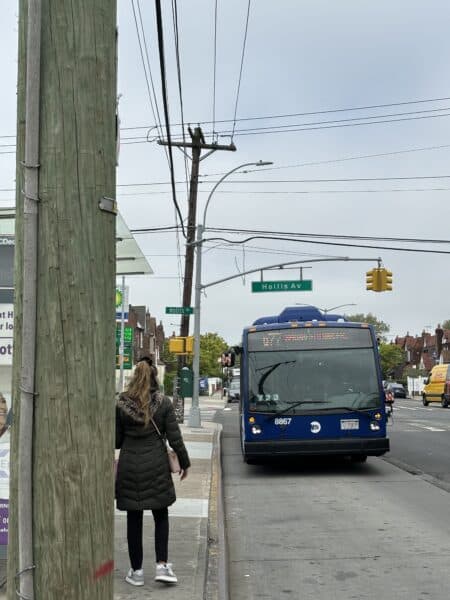
Waiting for the Q77 bus in Queens. Photo by Raydhira Rosario
Wishing for Better Bus Service in a Transit Desert
QUEENS, New York
by Raydhira Rosario
Ever since my family moved to Eastern Queens, I discovered what it’s like trying to get around while living in a transit desert.
Dollaride.com defines transit deserts as “areas characterized by limited transportation, including poor public transportation options.” In the context of New York City, an area where it takes more than 10 minutes to walk to the subway would be considered a transit desert. In a report the Regional Plan Association described Eastern Queens, the North Bronx and coastal Brooklyn as some of the city’s transit deserts, according to the New York Times.
I’ve had to jump over hurdles when trying to get from point A to point B. One of the main reasons for that is the Q77 bus. I almost always have to wait over 10 minutes. My experience resonates with other riders. Diane Sutherland, a frequent Q77 rider said, “I wish it were easier to get to other places, to travel we have to switch so many buses.”
Yndiana Martinez also wishes we had better bus service. “This bus doesn’t pass often, when I’m in a rush I end up having to wait so long,” she said.
Because most of the Q77’s neighborhoods are transit deserts, this bus and its similar routes are the only way that residents can get to the 179 and 169 Street stations on the F line. Despite the usually long wait times, I and many others appreciate that the route exists because of its subway connection. “The bus is good, but it takes too long to pass sometimes,” said Beoneve Dorsaint as he waited for the next one to arrive.
We could have another alternative, but it is too expensive for a lot of us. The Long Island Railroad is not too far from the area. But the $5.75 ticket price during peak hours and $4.75 during off-peak is more costly than the $2.90 fare on subways and buses.
I am optimistic about the Q77’s future because the MTA has a plan to re-design the Queens bus network. The Queens Chronicle reported that, “The agency is proposing to extend, realign, straighten or shorten the Q1,5,7,77,86 and Q110 bus routes to improve speed and reliability.”
I have been aware of the MTA’s redesign plan for two years now and I am eagerly waiting for it to come into effect so that I and all of the people living in one of the borough’s transit deserts, can have a better commute and maybe even start to enjoy it.
Do I Feel Safe On the Subway?
MANHATTAN, N.Y.
by Marquiese Monterro
Many students at The City College of New York (CCNY) rely on the subway to get to school and have strategies they use to mitigate their fear of getting attacked or harassed. They are observant, some travel in groups, and avoid certain routes or times of day.
Sally Castillo, commutes to City College from Brooklyn and feels like she needs to be alert.
“I see a bunch of homeless people sleeping in the cars especially on the 4 on Utica when I get on,” Sally said.
Governor Kathy Hochul has deployed about 1,000 national guard troops to provide security. The guard members are temporary and are focused mainly on the busy stations and key transfer points during peak rush hours.
Their deployment has been met with different reactions and Castillo is not a fan. “Overall, I don’t feel safe on the train and that’s why I usually have someone to go home with.”
Another student, freshman Juneah Samuels, also travels from Brooklyn and she is one of many students who feel unsafe.
“Do I feel safe on the subway? Absolutely Not!,” she said. “I usually see people on their phones or sleeping, sometimes crackheads, bums, sometimes fights or arguments. The commute to school, however, isn’t bad. “There are less crazy’s out during school hours” she said.
Senior D’Andrea Simmons takes the subway from the Bronx. “I see crackheads sleeping on the train.” She explained that she doesn’t take a seat while waiting for her train. “I stay alert cause you’ll never know if someone is walking up behind you or anything” She said.
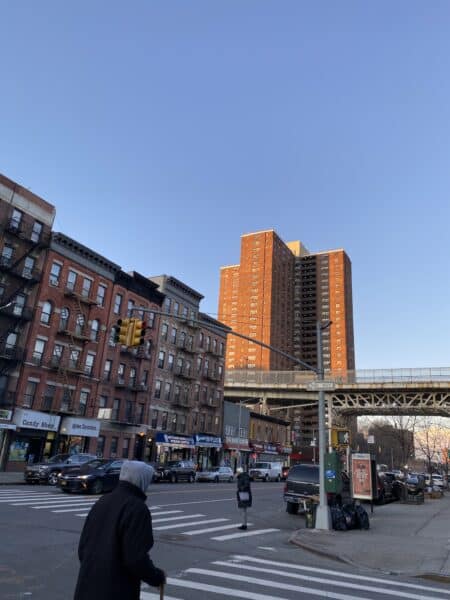
Harlem, 154 Street. Photo by Malik Petersen.
A Walk Through Harlem
by Malik Petersen
CENTRAL HARLEM, N.Y.
My commute to school is truly short. It takes me twenty minutes and I do not have to take the train or subway. I usually do not feel any stress and I meet some friends and family on the way to school. I start out at 154th street and Eighth Avenue and as I walk everyday, I meet a lot of people.
The Harlem neighborhood where I was born, raised and still live is changing a lot. White people, South Asians and a lot of Africans and Migrants had moved in my neighborhood. I live closely to Rucker Park, home to the famous basketball courts where I have seen many basketball stars in the yearly tournament including the late Kobe Bryant and Kevin Durant.
I like talking to people on my walk. Maria Blasina from Dominican Republic owns Blasina Hair Salon. She is concerned about the spike in crime in our neighborhood from shoplifting to vandalism. I think that she should be concerned because robberies are up 40% in the 32nd Precinct, according to the New York City Police Department’s (NYPD) Comp Stat.
Maria said that “she is scared to close up at night by herself because anybody can run up behind me and rob me.” I am scared of my life,” she said. But this shop is her life. She said“Having more police in her neighborhood showing that presence would help with quicker responses and that will ensure her safety and the community has to be engaged. If the community has good surveillance and visible deterrence the neighborhood can be safe.”
Tyrone Gibbins is a passionate community activist who was also born and raised in Harlem. He thinks garbage is a big problem and I agree because truckers dump all types of trash near the post office close to my apartment. But Tyrone said, “While the city provides regular garbage collection services, illegal dumping and littering remain and persistent problem. That is why if I see anybody illegal dumping on my block I try to tell them the correct place to out their trash,” he said. Tyrone also thinks that there is a need for “Organizing neighborhood clean up events and advocating for stricter enforcement of anti-littering laws to address the issue effectively.”
Cynthia Jenkins retired from her job as a school crossing guard after twenty years. She’s lived in Harlem for over 60 years and has seen a lot. Mrs. Jenkins is not worried about new people moving in but she is concerned about the kind of gentrification that pushes longtime residents out of Harlem. She said, “In Harlem, the influx of new high rises is displacing longtime residents, causing concern about the change in the community. It’s disheartening to see familiar faces forced out due to rising rents and property values. We need to ensure that development benefits everyone and preserves the cultural heritage of Harlem.”
Conversations with these people and others makes my walk to school feels like a blessing.
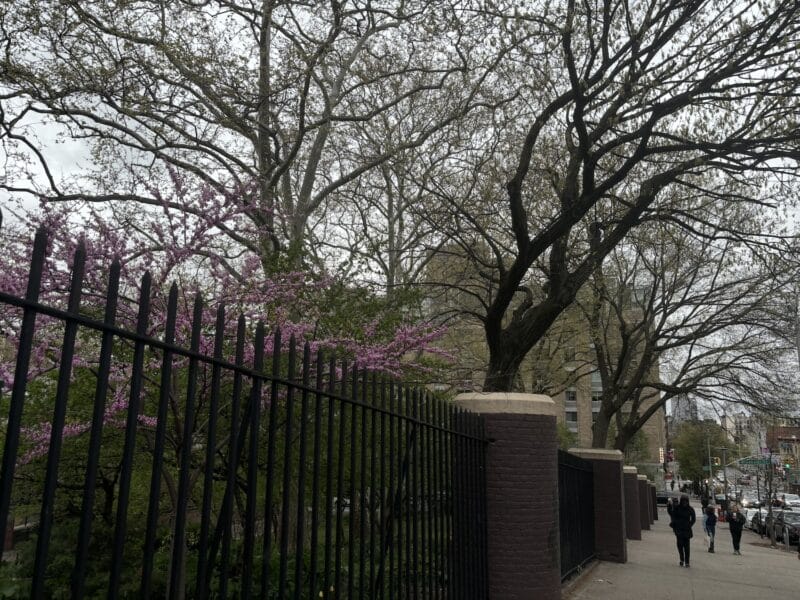
The edge of Jackie Robinson Park on 145th Street. Photo by Laura Lentz.
A Pleasant Walk Up a Harlem Hill
by Laura Lentz
My walk to The City College of New York (CCNY) everyday feels like a blessing when I hear the commuting horror stories from my classmates. Despite the steep hill on 145th Street, stretching across four avenues, my daily commute seems like a walk in the park compared to my classmates. I enjoy the scenic and friendly atmosphere, Jackie Robinson Park is one side of 145th when I start out, and family owned businesses line most of the street.
I always try to take a moment to appreciate the community and take a breath of fresh air. Others seem to feel the same way about the neighborhood and the walk.
Jaclyn Vu has lived in the neighborhood since August of 2023 and enjoys 145th Street. “It is great to see people enjoying time with their friends and family,” Vu said.
Residents on and around 145th Street create their own community and safe spaces. Jocelyne Hernandez has worked in the neighborhood for about three years and enjoys the variety of people. Hernandez said her favorite spot is Sugar Hill Cafe. “I get my coffee from there whenever I am in the area,” Hernandez said.
Zaria Glenn has lived in Harlem for four years. She walks up 145th Street to City College most days. While she appreciates the liveliness of 145th Street, she is not a fan of the steep hill. “The incline walk from my apartment building is tough,” Glenn said.
Small luxuries in life are often looked over in our busy day to day life. If you walk up the hill at 145th Street, why not take a second to appreciate this lively, sloped street.
Tags: candy sellers on the subway crime in subways Fairuz Omar Raya Francina Saint-Hillaire Julian C. Rivas Katelyn Polanco Kenneth Morales Lizbeth Fuentes Ascencio Malik Petersen Marquiese Monterro National Guard in subways Raydhira Roasario subways
